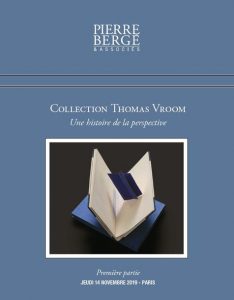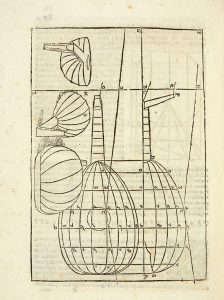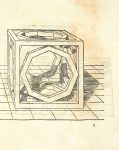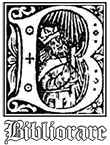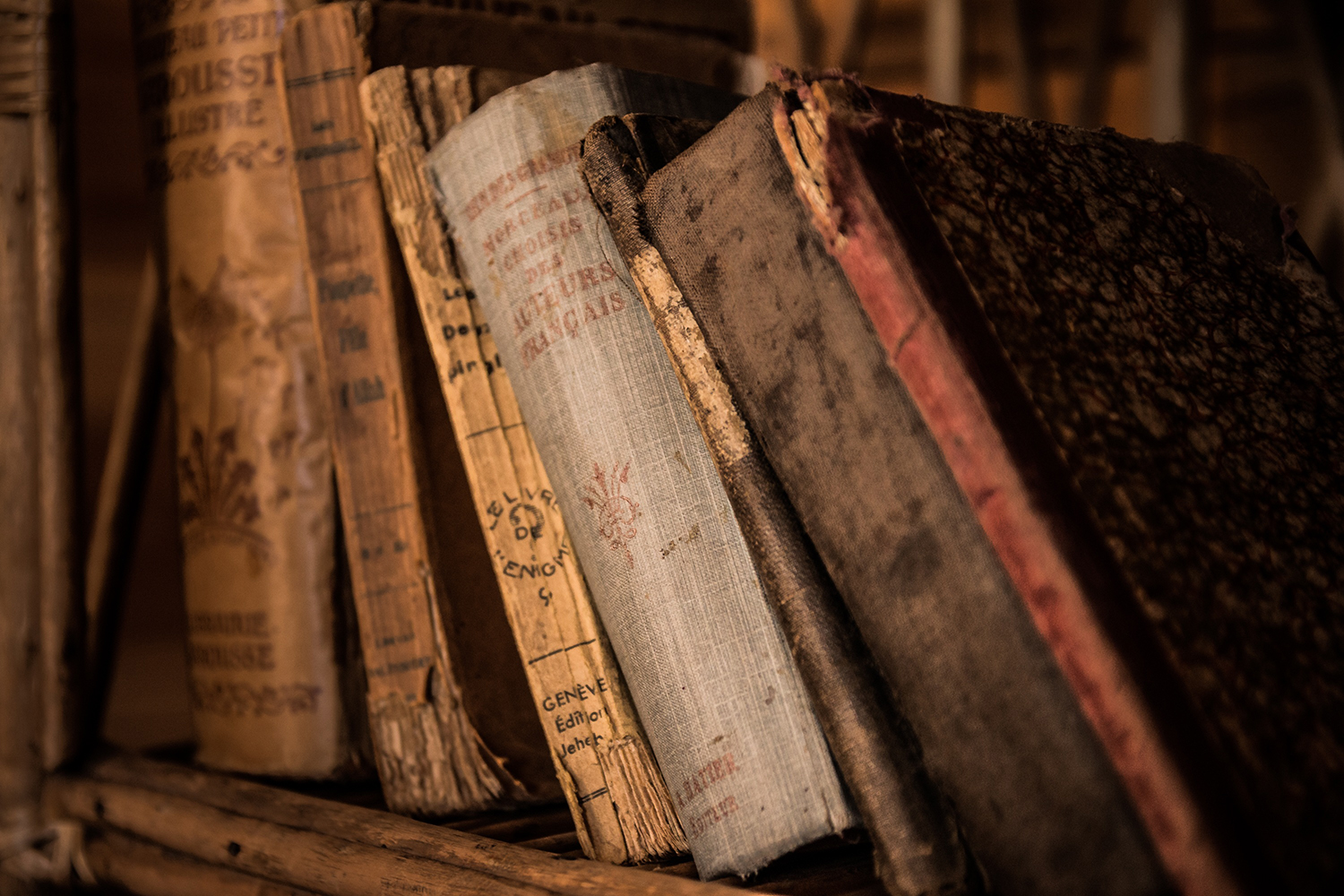Description
Florence, Pietro Cecconcelli, 1625. Petit in-folio (303 x 217 mm) de 6 ff.n.ch., 152 pp., 2 ff.n.ch., (1 f. avec deux grands bois recto-verso, et le feuillet de registre), nombreux schémas dans le texte; vélin souple, dos lisse (reliure de l' époque).
Fowler, 1; Vagnetti EIIb13; Vitry, 1.
Édition originale de ce manuel de perspective pratique, essentiellement à l'usage des peintres.
L'ouvrage, dédié à Carlo de Medici avec ses armoiries sur la vignette de la page du titre, est divisé en trois grands chapitres dont le dernier est exclusivement consacré au traitement de la lumière et des ombres. Le dernier chapitre contient notamment la première version imprimée du célèbre traité de Léonard intitulé Discorso intorno al disegno (pp. 144-152).
Provenance: F. Baretino (note sur la garde) - Favia del Core (ex-libris).
First edition of this practical manual of perspective, of special interest to painters. It also contains the first printing of Leonardo's treatise on painting, Discorso intorno al disegno (pp. 144-152). The book extensively treats all aspects of perspective including anamorphoses, light and shadow, and the camera obscura.
Les origines de ma passion de collectionneur se trouvent en Italie. Au début j'étais surtout intéressé dans “l'art de la surface plate” des alentours de Sienne.
Lorsque j'avais quinze ans, j'ai visité avec mes parents le Palazzo Ducale à Urbino en Toscane où la merveilleuse fresque de Piero della Francesca - La Flagellation du Christ
- m'a donné une fascination permanente pour la perspective. Comment des artistes arrivent-ils à créer avec des surfaces et des lignes, avec des couleurs et des figures, avec des formes et des proportions une perspective parfaite ? De cette fascination j'ai assemblé une collection de livres de savants et d'artistes du quinzième au vingtième siècle qui se sont intéressés au secret de la perspective. J'ai été très heureux de réunir cet ensemble pendant les quarante dernières années, et j'espère que tous ces beaux livres trouveront maintenant leur place chez d'autres collectionneurs passionnés.
Thomas Vroom, Holten, Novembre 2019
What is the use of perspective books ?
The magnifi cent Vroom Collection of books on and related to artist's perspective, some of which were grandly illustrated and expensive, raises the question of what were they originally for. Who read them and why? The answer seems obvious. They were designed to train aspiring painters in linear perspective; that is to say in the geometrical technique of plotting on a fl at surface the relative sizes of objects behind the picture plane or “window”. This was accomplished according to an optical rule that decrees that the objects are seen from a single, fi xed viewpoint at a single moment in time. Perspective seems to allow us to become an eyewitness to what the painter sees in reality or imagination (or both).
The technique of linear perspective, either via conscious construction or via standard photographic representations, is immensely powerful and compelling. It triggers very basic proclivities in how we see space, without serving as a literal record of how the eye and brain actually work in the incredibly complex and fl exible mechanisms of perception and cognition. In our modern world, it has triumphed over all other modes of representation in the popular media.
It seems obvious therefore that it provides the foundation of naturalism for any artist who want to convince as that were are looking at the “real thing”, or at least a surrogate that stands in effectively for the “real thing”. However, if we search for evidence of young artists spending hours mastering the technical constructions in which the books delight or of mature artists meticulously deploying the techniques in composing their pictures, either in preparatory studies or within the fi nal painting, we will fi nd only patchy evidence. There are the causes célèbres of the perspectivist's art: Masaccio's Trinity, Uccello's idiosyncratic constructions, Piero della Francesca's Flagellation, Raphael's School of Athens, illusionistic vault and dome paintings in the Baroque, some numbers of paintings in the pedantic tradition of European academies, countless Dutch interiors (especially of churches); and topographical veduta paintings of the Canaletto kind, not least in Britain. There are more, but the count of paintings that openly parade precise perspectival techniques comprises but a small fraction of the total that we see when we journey round the world's great galleries of old masters. Most paintings in the mainstream “Western” tradition for about fi ve centuries exploit spatial techniques - lines of objects inclined into the picture and subject roughly to a vanishing point or points, the relative scales of items at different depths in space, and gradients of texture, colour and atmosphere - but few follow perspectival rules with anything like mathematical exactitude. Before attempting to explain the apparent paradox of instructional looks whose instructions are not generally followed, let is look at what the books typically contain, either in whole or in part, and noting why contain these elements.
The grander of the volumes are endowed with a fi ne title-page or frontispiece.*1 We may well see classically dressed fi gures (usually female and representing such pursuits as painting and geometry), often accompanied by pudgy infants. The setting is generally architectural, plotted with due care for perspective. The protagonists, old and young, busy themselves with the accoutrements of the perspectivist's' art, such as geometrical tools and linear constructions, instruments of mensuration and perspective devices, and panels or canvases on which perspectives are being drafted. If a directional light bursts from the skies, so much the better for the divine status of optics.
The conception of such illustrations is to endow perspective and painting more generally with status - not as a material craft but as a “liberal art” that has rational and even scientifi c foundations.
Painting can justly be seen branch of practical mathematics, akin to music with its Pythagorean harmonies.
Some of the books, most notably German ones of the 16th century, regale us with surreal compositions of geometrical solids of an regular and bizarre kind, as a kind of plastic music.*2 We can extend the intellectual motivation that drives such pages more broadly to the agendas of the academies of art that rose across Europe following the lead of the Florentine Academia del Disegno in 1563. The message was also directed to a broader society, not least via royal and powerful patrons, as typifi ed by the dedication of a number of the grander books. At telling example is Joshua Kirby's publication in 1754 of the perspective system of Brook Taylor, a noted mathematician. The resulting volume with its witty frontispiece by Hogarth was dedicated to George III*3.
The introductions that the authors provided for their volumes typically mirror the implicit intellectual claims of the frontispiece and social aspirations of the dedication. The idea is to show that art is a learned discipline. Authors characteristically claim that what is to follow surpasses other treatises in novelty, optical and geometrical accuracy, intelligibility and practicality
Some basic geometry and sometimes some basic optics typically follows, though more of the former than the latter. There may well be some basic Euclid, especially of simple geometrical shapes, basic constructions such as similar triangles, and three-dimensional illustrations of geometrical solids (most notably the fi ve regular or “Platonic” polyhedra).*4 The Euclidian and Platonic connotations were useful and served to make a philosophical point about the “ideal” status of geometry and therefore of art. Next we would expect to witness the basic geometry of projecting simple forms that are behind the picture plane on to that plane, given a fi xed point located at a given distance from the front of the plane. The really serious books depict compound solids in perspective and show how the ground plans and elevation of a complex objects, especially architectural components or whole buildings, can be projected at any given angle on to the picture surface. We might expect on occasion to fi nd provide alternative and abbreviated methods, some aimed at encouraging young devotees.
There are some set-piece examples that recur across the treatises, acting like fi ve-fi nger exercises on the piano. Early Italian examples include mazzocchi, the facetted doughnut frames that supported voluminous hats, fi rst illustrated by Uccello and Piero della Francesca*5. Lutes are favourite subjects, portrayed at various angles.*6 Spiral staircases - a real challenge - serve to certify the author's competence.*7 We fi nd pictures of optical instruments, most obviously in books that discuss surveying*8 and even artists' easels*9. There are also arrays of the letters of the alphabet depicted as sculptural objects and placed in diverse orientations.*10 The choices seem to be based upon stock ideas of what a trained perspectivist was expected to accomplish.
A number of treatises deal in more detail with the issue of placing complex semi-regular or irregular forms, most notably the human body, systematically foreshortened as if seen from the fi xed viewpoint.
The most accurate method was to project the human body in plan and elevation, as demonstrated by Cousin,*11 but there was also a short-hand technique of reducing fi gures to a series of box-like components within which the detailed forms could be foreshortened.*12
Complementing the projections of the bodies, a number of the treatises deal with the geometry of shadows cast by various bodies under illumination from given sources of light.*13
Mechanical or optical devices or instruments for the achieving of perspective constructions in an automated manner are illustrated and discussed by some of the authors. The simplest are the glass and “veil”, which allow the direct transcription of the seen thing from a fi xed view point on to a fl at surface*14.
There are also quite elaborate optical machines in which some kind of sighting device is angled towards a given point or contour on an object, while a mark-making component moves across what is to be the picture plane registering the optical location of the point or contour*15. Dürer was the earliest master of such things.*16 Such “perspectographs” were indeed made and some examples have survived from later periods. But they seem generally to be more in the nature of prestigious devices for demonstration purposes rather than serving the utilitarian needs of practicing painters.
The making of such fi ne technical instruments became a matter of pride from the 16th century onwards.
We also fi nd some illustrations of the camera obscura, the “dark chamber” with an aperture in one of its sides that served to create an inverted image of what lay illuminated outside the “camera” (with or without the assistance of a lens).*17 The “camera” features somewhat less frequently than we might expect, given its likely use by Dutch and Dutch-infl uenced artists from the 17th century onwards. Most authors are concerned with geometrical rectitude than the direct transcription of raw nature.
Our archetypal book may well conclude with worked examples closer to the desired paintings of subjects that were current at the time and place of the publication. The Italians and Dutch stand at the opposite end of the scales. Italian 16th century and Baroque treatises are likely to emphasise grand architectural constructions in an all'antica manner and heroic fi gures, especially as projected illusionistically on to ceilings, vaults and domes. Such architectural projections are represented most spectacularly by Pozzo.*18 The Dutch, unsurprisingly, follow a more empirical bent with constructions of domestic rooms containing clearly scaled furniture and inhabitants*19, urban views, lofty church interiors, and landscapes with perspectival motifs such as rows of trees and artfully placed boats on calm waters.
The Vroom collection allows us to chart the diffusion of the perspective book, from its origins in Italy, closely followed by France, where the earliest illustrated treatise was published in 1505, the eccentric and pioneering treatise by Jean Pelerin (Viator).*20 Germany, an important cradle of northern humanism, followed with the supremely important Instruction in Measurement... by
Dürer in 1525.*21 Thereafter we witness the spread to Holland, Belgium, Spain, Portugal and eventually to 18th century Britain, where the belated perspectivists associated themselves with the international prestige of Newton. While many of the treatises were published in the vernacular, Latin continued to be used on an international basis. Dürer's book, translated into Latin by Camerarius in 1532, served to bring the artist's vernacular geometry into scholarly circulation.*22
It was during the 16th century in Italy that the projective geometry of perspective received sophisticated attention from Commandino and Guidolbaldo del Monte, both from the city of Urbino, while the elegant treatise by the architect Vignola was published in defi nite form with a mathematical commentary by Danti.*23 Stevin played an equivalent mathematical role in Holland.*24 Perspective was entering mathematics, most notably via the projective geometry of Desargues in France, whose protégé Bosse taught perspective with dogmatic insistence at the French academy.*25 We can tell that matters were becoming serious when principled polemics about the correct method began to rage in the 16th century, as in the dispute between Bassi and Tibaldi about an illusionistic Annunciation by the latter on the Baptistery in Milan.*26 During the next century, “perspective wars” broke out in French academic circles, involving Bosse, Curabelle and Dubreuil.*27 The technicalities of the arguments that were deployed must have gone over the heads of most practitioners.
Looking at the generality of the books, it is clear that they comprise a special genre in their own right, rather like the picture-books of anatomy, which had little utility in the actual practice of medicine, but which certifi ed the high knowledge levels required of major surgeons. The most spectacular of the anatomical books belonged in the learned libraries of major patrons and a few elite medics rather than in the rooms of routine doctors or even in monastic hospitals. A few artists possessed substantial libraries with books on perspective, though the proportion increased over the course of the centuries as the cost of the textbooks came down and artists' earnings improved.
Within the world of publishing the genre of perspective treatises thrived in a broad context of practical mathematics, a discipline represented by upwards of 20 books in the collection that contain sections on perspective. We fi nd perspective conducting liaisons with the projective geometry of sundials,*28 the viewing of astronomical phenomena,*29 and the practice of surveying.*30 There were also links with garden designs.*31 Most commonly, perspective is associated with the devising and communication of architectural structures, civil and military. A number of the books in the collection involve military design, above all of the intricate geometrical structures of advanced fortifi cations in which lines of fi re and the angles of bastions obey a kind of visual ballistics of form and space.*32 Another branch of architecture that deployed projective techniques was that of stereotomy or stone-cutting,*33 which was used to calculate the angles of the faces of abutting stones in complex arches and vaults. Perspective belonged integrally with the great scientifi c and technical revolutions from the Renaissance onwards, in which vernacular skills were newly claiming foundations in the mathematics of nature.*34
But we have not yet mentioned what was perhaps the most sensational and large-scale function of perspective design, that is to say in theatrical spectac
lars. By nature ephemeral, with the most notable exception of Palladio's Teatro Olympico at Vicenza,*35 great stage sets situated human protagonists in front of streets and buildings that seemed to be plunging into the far distance. The biggest and best have disappeared and are ill-served by illustrative engravings. The earliest woodcuts of stage designs appear in Serlio's books on architecture,*36 using a system that was thought to be ancient Roman.
The greatest of the designs were breath-taking, combining optical illusion of deep recessions with actual forms in high and low relief. The technique was more elaborate than in standard painting.*36
The cost of such illusionistic constructions was very high and the masters of stage design were much admired. Most famed in the 18th century was Bibiena, who invented the scena al angolo, in which the corners of the nearest buildings were angled towards us, framing avenues that dashed dramatically into angled spaces of indeterminate depth.*37 The set itself became a drama, in the same way that
Piranesi's monumental etchings of nightmare “prisons” exploited diagonally disposed architectural forms and spaces as the main protagonists in his assertive displays of dynamic space.*38
A related facet of perspectival design involved a kind of natural magic in which wonder and astonishment were the prime ends in view. Some of the perspective books in themselves cultivated the “wow” factor, such De Vries's elaborately confected scenes of buildings in perspective.*39 In 17th century Holland we also encounter “perspective boxes”, optical peepshows which beguile us with a precocious form of virtual reality - the most famous of which is the elaborately staged box of optical tricks by Hoogstraten in the National Gallery, London. Perhaps the most wondrous of the effects were created by anamorphosis, in which an image projected from an extremely shallow angle of view outside one lateral edge of the picture plane was reconstituted into a naturalistic illusion when viewed from the corresponding position.*40 In 17th century Rome, Maignan and Niceron (whose copy of Dürer is in the present collection) used the anamorphic technique to conjure up a visionary image of St. Francis of
Paola in a corridor in Sta Trinità dei Monti.*41 The title of Niceron's own learned and splendid treatise, Curious Perspective or the Artifi cial Magic of Marvellous Effects, perfectly captures the spirit of the enterprise*42. Generally with such extreme illusions, some of which involved cylindrical and conic mirrors,*43 entertainment rather than devotion was involved.
As expanded public access to visual entertainments developed in the later 18th and 19th centuries, we encounter miniature pop-up theatres constructed from card, mirroring the optical delights of fullscale scenery. Only a small proportion of them survive. The present collection contains a fi ne set of
Theatres d'Optique, together with a Polyrama Panoptique, which used light effects to enhance views of Paris, and a Telorama tour of the Rhine. The “scientifi c” titles are designed to enhance the viewers participation in a privileged “modern” experience.*44
By the time we reach the 18th and early 19th centuries we fi nd on one hand books of sober and technical geometry, projective and descriptive (dealing with the nature of 3-D forms rather than their optical appearance), which moved beyond the concerns and grasp of most painters, and were not designed for visual appeal.*45 The teaching of perspective at a technical level also persisted in military academies. On the other hand we have publications of more affordable text-books, neatly illustrated and parading manageable techniques. The more pedagogic of the books are aimed not least at the kind of well-bred amateurs who were instructed by drawing masters in the rudiments of topographical art.*46 The well-dressed young lady in the treatise by Pensée*47 accurately refl ects one intended benefi ciary of the instructions.
During the course of the 20th century, accurate delineation of “real” scenes using optico-mathematical means was largely superseded by different notions of vision, both spatial and imaginative. The great age of perspectival naturalism was past, unless we take into account its mass survival in photography and photographically-based art forms and entertainments. The three perpendicular axes within the frame of our computer schemes are basically the same as those used by Piero della Francesca.
However, as the outstanding group of modern artists' books in the present collection serve to show, a genre of “perspectival” magic still thrives.*48 The images that Flocon provided for the texts of Eluard, the Surrealist poet, echo the dream-like assemblages that appear in the 16th century treatises. We fi nd
Barton continuing the link with map-making, Billingham exploiting pop-up and stereo effects, Lewitt creating illustrations for texts by Borges, that great master of literary deception, and Denes summoning up curved bodies on fl at pages. Typically the artists' book, as in the hands of Hofstra and Smith, treats the book itself, with its illusionistic pages, as a specifi c object, as a sculptural body in its own space.
Will perspective live again in contemporary art? Forecasting in the creative arts is hazardous. Either way, the fi ve or six centuries in which the major perspective books were created, thriving in a broad nexus of practical mathematics and systematic naturalism, continue to exercise their own particular fascination and beguiling visual magic.
Martin Kemp
Note: The item numbers in the margins provide a guide to examples but are not intended as a comprehensive listing of types of treatise or of illustrations
